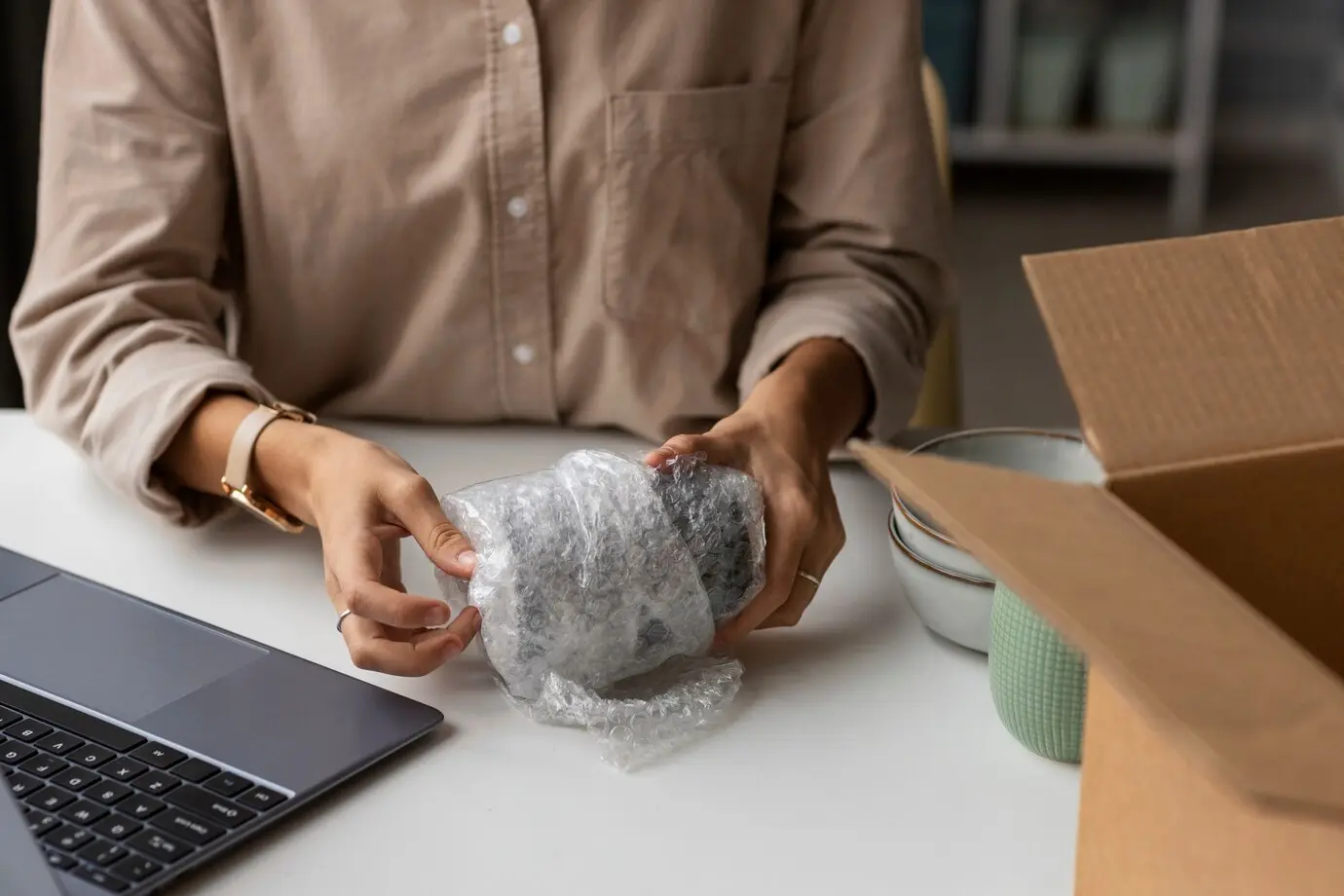What is Frustration Free Packaging? | Benefits & How It Works

Ever ordered something online and spent more time opening the package than using the product? Layers of plastic, zip ties, clamshells, you know the drill.
Now imagine this: the same product arrives in a simple, easy-to-open box. No scissors. No struggle. Just clean, hassle-free unboxing.
That’s the promise of frustration-free packaging. And as more businesses shift focus toward user experience and sustainability, this approach is no longer optional—it’s expected.
What Is Amazon Frustration-Free Packaging?
Amazon introduced Frustration-Free Packaging (FFP) back in 2008. The goal was to make opening a package less of a headache.
Instead of the usual layers of plastic, twist ties, and oddly-shaped boxes, FFP focuses on minimal, easy-to-handle packaging.
But it’s not just about convenience.
Frustration-free packaging is also about sustainability. It uses materials that are 100% recyclable, like plain corrugated cardboard, and avoids anything unnecessary such plastic inserts, zip ties, or complicated wraps.
This type of packaging is tested to ensure products stay protected during shipping, but with far less waste. So it’s a win-win: better experience for the customer, and less strain on the environment.
For brands selling through Amazon, FFP has become more than a nice-to-have. It’s often a requirement. And for customers, it’s becoming the new standard for what a “good” unboxing should feel like.
Frustration Free Packaging vs Standard Packaging
If you’re torn between frustration-free and standard packaging, it helps to break things down clearly.
1.Design and Ease of Use
Standard packaging tends to prioritize protection and presentation. It’s the kind you’ll see wrapped in plastic, sealed with layers of tape, and maybe even needing a box cutter to get through.
Frustration-free packaging flips that logic. It’s designed to open easily: no tools, no mess. Tear strips, easy-open tabs, and minimal layers mean the product gets into the customer’s hands quickly and without hassle. The unboxing experience feels smooth and intentional.
2. Sustainability
Frustration-free packaging was built with sustainability in mind. It uses fewer materials and sticks to recyclable options like cardboard. Less waste. Smaller carbon footprint. It sends a message that your brand cares about the planet.
Standard packaging, on the other hand, often includes plastics, foam, and other materials that are tougher to recycle. It may still protect your product well but it can also create more waste.
3. Customer Experience
Unboxing matters more than most brands realize. A clean, frustration-free unboxing feels thoughtful. It creates a positive first impression, builds trust, and makes people more likely to share that experience.
That said, standard packaging still has a role. For luxury goods or fragile items, the layered protection and premium feel might actually enhance the experience.
4. Costs and Business Impact
There’s a common assumption that frustration-free packaging is more expensive. And upfront, it can be especially with custom designs. But over time, it may cut costs through better packing efficiency, fewer materials, and lower shipping weights. Plus, it can reduce returns by improving product protection during transit.
5. Compliance and Sustainability Regulations
With increasing focus on eco regulations, frustration-free packaging often helps brands stay ahead. It’s designed to meet stricter environmental standards, which can reduce risks of non-compliance and support a company’s sustainability claims.
Standard packaging may meet minimum requirements, but it might not hold up as regulations evolve.
6. Operational Efficiency
Frustration-free packaging simplifies packing, sealing, and shipping. Less time, fewer steps, fewer errors.
Standard packaging can slow things down. Complex shapes, extra layers, and additional components mean more time and labor. That can affect delivery timelines and even customer satisfaction.
7. Branding and Market Positioning
Standard packaging often wins on branding. It offers more surface area, more finish options, and more ways to create a “premium” look.
Frustration-free packaging, while minimalist, isn’t branding-free. It just needs a smarter approach, clean design, clear messaging, and purposeful simplicity can still make your brand stand out. Plus, the sustainability aspect itself becomes part of your story.
Why is Frustration Free Packaging Cheaper?
At first glance, frustration-free packaging might seem like an added expense (custom designs, better materials, and extra planning). But in reality, it often turns out to be more cost-effective.
Why?
Because it uses fewer materials, takes up less space, and is quicker to pack. That means lower material costs, reduced shipping weight, and more efficient operations. Less time spent packing each order also means reduced labor costs.
Over time, these savings add up. Plus, fewer returns due to damaged goods and better customer experiences can directly impact your bottom line.
Benefits of Amazon’s Special Fulfillment Programs
Amazon’s special packaging programs, like Frustration-Free Packaging and Small & Light, aren’t just about reducing waste. They’re built to support sellers too.
For starters, products in these programs can get extra visibility through Amazon’s merchandising and promotional opportunities. That means better placement, more clicks, and potentially more sales.
The packaging itself is also designed to cut down on costs, less material, lower shipping weight, and faster packing processes. That adds up to savings across your supply chain.
Certification is free, and the approval process is quick. Sellers just need to submit product samples, and most evaluations are wrapped up within a couple of weeks.
But the real win? A better customer experience. Easier packaging means happier buyers, better reviews, and stronger seller feedback. All of which improves your chances of winning the Buy Box.
Amazon Frustration-Free Packaging Setup
Getting started with Amazon’s Frustration-Free Packaging program is a straightforward process.
First, you’ll need to design your packaging according to Amazon’s guidelines, minimal materials, fully recyclable, and easy to open without tools.
Once ready, you submit samples of your product for testing and certification.
Amazon evaluates the packaging for durability, sustainability, and ease of use. If it meets their standards, it gets approved usually within a couple of weeks.
Once certified, your product will carry the Frustration-Free Packaging badge on its listing, giving it more visibility and credibility with eco-conscious buyers. It’s a one-time setup that can lead to long-term benefits.
What To Do If You don’t Qualify For Frustration Free Packaging?
Not every seller qualifies for Amazon’s Frustration-Free Packaging program and that’s okay. There are still smart alternatives to explore.
- Small and Light
If your products are compact and lightweight, Amazon’s Small and Light program is worth a look. It reduces fulfillment fees and offers free shipping to customers, without requiring major changes to your current packaging. Enrollment is quick and simple. - Subscribe and Save
Got a product customers need regularly? Enroll it in Subscribe and Save. It helps you build recurring revenue through repeat orders while offering discounts to loyal customers. - FBA Export
Selling globally doesn’t mean setting up in every country. With FBA Export, you can reach international customers directly from your U.S. inventory.
Even without FFP, these programs can give you an edge with cost savings, improved reach, and better customer retention.
How To Choose The Right Type of Packaging?
Start with your product. Is it fragile, high-end, or meant to impress visually? If yes, standard packaging might offer the structure and branding space you need. But if your goal is a smooth, sustainable, and user-friendly unboxing experience, frustration-free packaging is the better fit.
Next, consider your audience. Eco-conscious customers expect minimal, recyclable packaging. On the other hand, gift buyers or premium shoppers may prefer a more polished presentation.
Also, think about your operations. Are you aiming to reduce packing time, shipping costs, or packaging waste? Frustration-free options often make things leaner and more efficient.
In a Nutshell
Frustration-Free Packaging isn’t just about less tape and fewer boxes. It’s a smarter way to pack, focusing on ease and sustainability.
While not every product or seller will qualify, understanding the benefits and alternatives helps you make better packaging choices.
FAQs
What is Standard Packaging on Amazon?
Standard packaging on Amazon refers to the traditional packaging used for shipping products. This often includes plastic wraps, clamshells, or extra layers of tape to protect items during transit.
What do customers have to say about Amazon’s Frustration-Free Packaging?
Customers generally appreciate Amazon’s Frustration-Free Packaging for its simplicity and ease of use. Many note how easy it is to open and value the eco-friendly materials used. The minimal packaging leads to a better unboxing experience, with fewer complaints about excess waste or difficult-to-open designs.

Jennifer James
My specialty is developing cost-effective, attractive, and appropriate packaging for protecting products. I am working with the company to design custom packaging that meets the client’s requirements.
